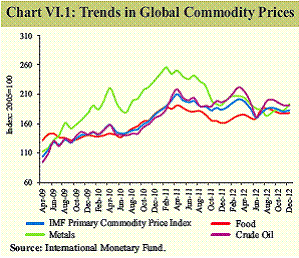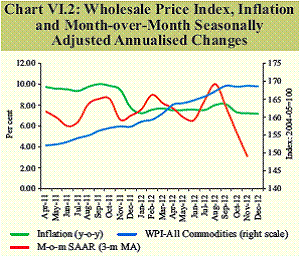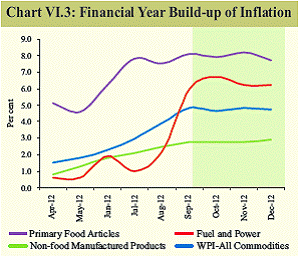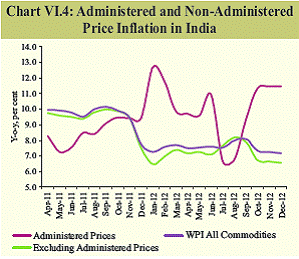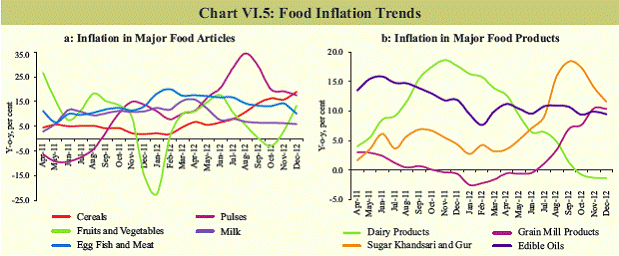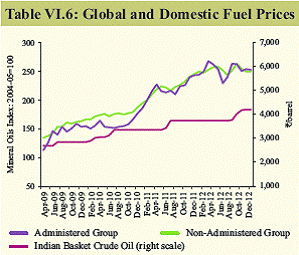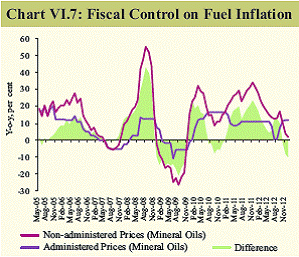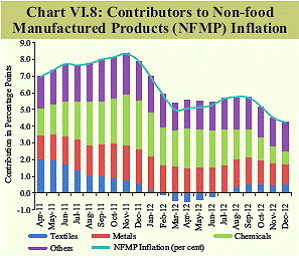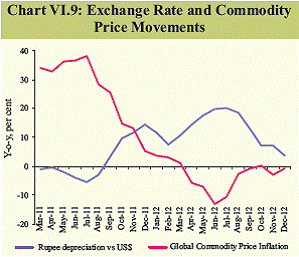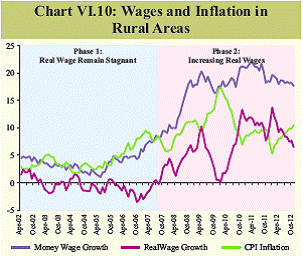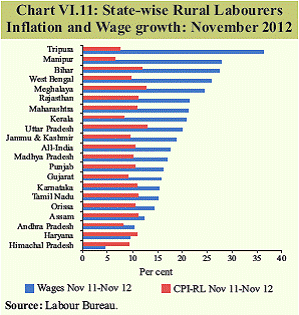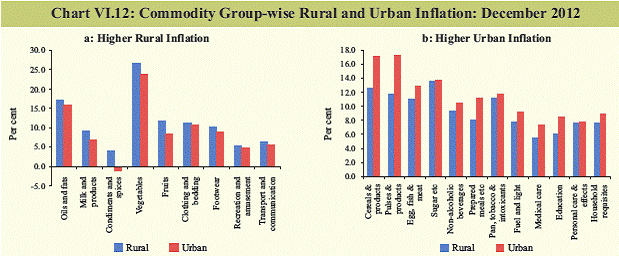VI. Price Situation - ಆರ್ಬಿಐ - Reserve Bank of India
VI. Price Situation
Headline inflation moderated from over 8 per cent in September 2012 to 7.2 per cent in December 2012. The significant slowdown in growth below trend led to a decline in non-food manufactured products inflation. Food inflation, however, continued to persist at elevated levels as new drivers emerged, which was also reflected in double-digit consumer price inflation. Inflation is expected to moderate gradually, supported by softer global commodity prices and weak domestic demand even though some pressure could be felt from the staggered increases in diesel prices. Also, there are continued risks from persistent price pressures from food, high inflation expectations and wage-price spiral, leading to further pressure on generalised inflation. Global inflation conditions remain benign, albeit with some pressure in EMDEs VI.1 Subdued global inflation environment in AEs continued into Q3 of 2012-13, as weaker global growth dampened demand conditions and commodity prices remained range bound. The average inflation in OECD countries was 1.9 per cent in November 2012, with core inflation (excluding food and fuel) being lower at 1.6 per cent. Among the major EMDEs, China recorded inflation of 2.5 per cent in December 2012, while inflation in Russia, Brazil and South Africa ruled above 5 per cent. Fresh round of quantitative easing (QE) enhances global liquidity VI.2 Continued weakness in the global economy has forced the central banks in most AEs to continue with extremely easy monetary policy of near zero nominal interest rates and quantitative easing (Table VI.1). VI.3 The US Federal Reserve (US Fed) expanded its QE from the start of 2013 with the expiry of Operation Twist. The Bank of Japan expanded the size of its QE further and in January 2013 adopted a revised inflation target of 2 per cent. The US Fed also tweaked its September 2012 forward guidance of keeping the target range for the federal funds rate at exceptionally low levels of 0 to 0.25 per cent until at least mid-2015 with an indication to do so till: (i) the unemployment rate remained above 6.5 percent, (ii) inflation between 1–2 years ahead was projected at no more than a 0.5 percentage point above its 2 per cent longer-run goal, and (iii) longer-term inflation expectations continued to be well-anchored. However, in January 2013 it indicated the possible end of QE before the end of the year on concerns over the sustainability of such large-scale asset purchases in view of risks associated with financial stability and the size of its balance sheet. VI.4 As the recovery prospects for the global economy remain weak (see Chapter 1) amidst high unemployment, spare capacity and subdued wage pressures, the monetary policy stance of AEs is likely to continue to remain accommodative. Following significant slowdown in growth in the recent period, more and more central banks in EMDEs have reduced their policy rates to address growth concerns. Muted global growth indicates range-bound global commodity prices in the near term VI.5 International commodity prices gradually moderated during Q3 of 2012-13 after exhibiting some uptick in Q2 (Chart VI.1). Crude oil prices moderated as supply prospects improved and geo-political tensions eased in the Middle East. Moreover, the prospects of a weaker global economy also played a role in keeping oil prices range-bound. Metal prices continued to show signs of weakening as demand has slowed significantly, especially from China.
VI.6 The near-term outlook on global crude oil prices indicates a softening bias as many of the factors that led to lower crude prices in 2012 continue to play out. While continued slow growth of AEs and EMDEs is expected to keep demand subdued, the prospects of improved production from a number of oil-producing economies along with a possible step-up in shale oil and gas production could keep overall demand-supply conditions in favour of lower price levels. However, a major decline in oil prices seems unlikely given the tight demand-supply balance, offsetting pressure from QE and the risks of geo-political tensions further feeding into oil prices. VI.7 International food prices moderated in recent months from the sudden spike witnessed in Q2 of 2012-13 following severe droughts this year in the US, a large part of Europe, central Asia and Australia. According to the Food and Agricultural Organization (FAO), the shortfall in global production of cereals, especially for wheat and coarse cereals could be met by drawdown of stocks. Despite some moderation, the current level of food prices remain significantly high compared to historical levels and food prices remain extremely vulnerable to shocks induced by weather-related disturbances, which have increased in the recent period.
Headline inflation moderated, but consumer price inflation remained high VI.8 Headline Wholesale Price Index (WPI) inflation (y-o-y) in India moderated from 8.1 per cent in September 2012 to 7.2 per cent (provisional) in December 2012. The moderation in inflation during Q3 of 2012-13 was faster than expected during the second quarter review. Vegetable and fruit prices declined as the south-west monsoon revived in the latter half. The moderation was also driven by a decline in the prices of freely-priced fuel products and metals in line with some moderation in their global prices. A range-bound exchange rate further helped this course. Moreover, the indirect impact of the diesel price hike in September 2012 remained contained, indicating that firms did not pass on rising input costs to output prices on account of weak demand conditions. VI.9 The build-up in price pressures seems to have tapered off in recent months, as the headline WPI remained almost flat (Chart VI.2). The momentum of price changes, as indicated by the 3-month moving average seasonally adjusted month-over-month changes, also indicate significant moderation. The financial year build-up of inflation during 2012-13 (up to December 2012) indicates that the price pressures that were building up in the initial months have eased significantly since September 2012, as prices remained range-bound in all the three major groups of the WPI (Chart VI.3).
VI.10 Though headline inflation moderated somewhat, price increases for items under administered prices have been much higher than those for freely-priced products in the recent period (Chart VI.4). Moderation in inflation, commensurate with slowdown in growth, is getting constrained by suppressed inflation coming into the open with administered price revisions, especially on fuel products such as diesel and electricity. Though such revisions add to near-term price pressures, they are desirable from a medium-term price stability objective, as suppressed inflation could lead to fiscal costs in terms of mounting subsidies that could turn inflationary.
Food inflation remains persistent as new drivers emerge VI.11 Food inflation continued to remain high as new drivers of food inflation emerged (Chart VI.5). With the late revival of the monsoon, prices cooled off, especially for vegetables and fruits. Price pressures, however, continued to remain significant for cereals and pulses, with financial year build-up of cereals inflation at 16 per cent and pulses at 19 per cent (up to December 2012). It may be noted that the impact of the delayed and skewed south-west monsoon was significant on the production of cereals and pulses. Inflation in protein-rich food items remained elevated, notwithstanding some moderation in recent months. VI.12 Manufactured food products inflation also remained near double digits, as price increases were significant in sugar, grain mill products, edible oils and oil cakes. The increase in edible oil and oil cake prices could be attributed to significant increases in oilseeds prices in the recent period. Though there has been some moderation in December 2012, y-o-y price increases in oilseeds remain high at 29 per cent. The increase in the price of oil cake, used as a fodder, could spill over to milk prices. VI.13 Persistent high food inflation has emerged as a major challenge for inflation management. There has been a significant increase in the cost of production in agriculture, driven largely by the increase in wage costs, which has also resulted in higher minimum support prices. Also, the changing pattern of consumption in favour of protein-rich items has not been matched by supply elasticities, which add to price pressures in these products. Augmenting supply capacities and integrating the supply chain by removing inefficiencies could be critical in achieving the goal of stable food prices. Moderate decline in fuel inflation aided by rupee appreciation, but suppressed inflation persists VI.14 The revision in diesel prices by ` 5 per litre in September 2012 led to fuel inflation reverting to double digits. However, in October and November 2012, prices of freely-priced fuel products declined aided by a stronger rupee and some decline in international crude oil prices. In December 2012, there was a marginal increase owing to higher bitumen prices.
VI.15 The revision in administered fuel prices and some decline in freely-priced fuel product prices led to partial closing of the gap between the two price levels (Chart VI.6). Despite this, the magnitude continues to remain large, which has resulted in the build-up of under-recoveries of the oil marketing companies (OMCs) to the tune of `1.25 trillion during April-December 2012, of which 59 per cent was on account of diesel. VI.16 Given this unsustainable level of under-recoveries, the government on January 17, 2013 allowed the OMCs to raise the retail price of diesel in a staggered manner and to charge bulk consumers of diesel taking supplies directly from the installations of the OMCs at non-subsidised prices. Accordingly, the retail price of diesel was increased by `0.45 per litre (excluding VAT) and the price of diesel for bulk consumers was increased by `9.25 per litre (excluding VAT) from January 18, 2013. The government also decided to raise the number of subsidised LPG cylinders per customer from 6 to 9 in a financial year. While the increase in diesel prices could lead to higher price levels in the near-term, the reduction in fiscal burden as prices get adjusted would help in medium-term inflation management.
VI.17 High domestic fuel inflation at a time when global fuel prices remained range-bound reflects the role that administered prices play in shaping the inflation trajectory. For most periods, inflation in administered fuel products remained well below the freely-priced products under the fuel group, contributing to suppressed inflation. Now, revisions of administered prices are driving up fuel inflation at a time when freely-priced products show a significant decline in inflation, thereby making fuel inflation more persistent (Chart VI.7). VI.18 Though global crude price (Indian basket) declined by about 2 per cent in dollar terms during April-December 2012 compared to the corresponding period in the previous year, in rupee terms it increased by about 13 per cent, owing to the depreciation of the rupee. Administered price revisions were much lower than the increase in global prices, which further increased the subsidy burden. This had also limited the demand adjustments to price and exchange rate signals, thereby leading to a widening of the current account deficit (see Chapter III for details). The recent revision in diesel prices could be expected to correct some of these imbalances. Core inflation pressure has eased and is likely to remain subdued amidst the slowdown VI.19 Non-food manufactured products inflation, the indicator of generalised inflationary pressures, declined considerably to 4.2 per cent (provisional) in December 2012 from 5.8 per cent in August 2012. The month-over-month seasonally adjusted annualised changes (3-month moving average) also indicate significant moderation in price pressures in recent months.
VI.20 The decline in inflation in this segment reflects both the impact of the growth slowdown, which has impacted the pricing power, as well as the pass-through of lower commodity prices, especially that of metals, as the exchange rate volatility has reduced. This also indicates the moderating impact of tight monetary policy on inflation, which is now becoming increasingly visible, albeit with a lag. VI.21 Within non-food manufactured products, ‘basic metals and metals products’ has been the major driver of the recent decline in inflation. It is also seen that the contribution of metals and chemicals to inflation in nonfood manufacturing has been significantly high in the recent period (Chart VI.8). Month-over-month price changes in most commodity groups remained marginal, indicating that the pressure on generalised inflation has ebbed significantly in the recent period. Depreciation of the rupee offset the impact of softer global commodity prices on domestic inflation VI.22 The impact of softer global commodity prices during 2012 compared to the previous year was expected to provide some comfort on generalised inflation, especially in items such as metals and chemicals, that have a significant weight in the non-food manufactured products component of the WPI. However, the depreciation of the rupee offset this favourable impact for most of this period, thereby leading to the persistence of inflation (Chart VI.9).
Risks to inflation persist from high fiscal deficit, if not contained VI.23 The high level of fiscal deficit and higher revenue expenditure by the government may add to the inflationary process. Incomplete pass-through of energy prices may result in higher subsidies, which are also inflationary. While in the present macroeconomic scenario of below-trend growth the risks to inflation from the fiscal deficit may not be visible in the near term, the medium-term inflationary impact cannot be overlooked. Empirical estimates indicate that the fiscal deficit significantly contributes to inflation in the long run. There is, therefore, a need to move towards further fiscal consolidation. Persistent wage inflation pressures may constrain inflation moderation VI.24 Recent trends in rural wages indicate that the pace of increase in rural wages moderated from a peak of about 22 per cent (y-o-y) in August 2011 to about 18 per cent in November 2012. This, along with an increase in inflation in rural areas in recent months, led to a decline in real wage growth to about 6.5 per cent in November 2012. Though a rapid increase in wages (both nominal and real) has been a common phenomenon during the current high inflation period, a comparison with the previous period (2002-07) reveals that a significant increase in real wages occurred only in the recent period (Chart VI.10). Empirical estimates of causality between wages and inflation in rural areas show that in the recent period causality ran from wages to prices, indicating that increase in real wages has been feeding into the cost of production and also sustaining demand, thereby leading to higher prices. State-specific factors also play a major role in wage-price dynamics as is evident from the large variation in inflation and wage growth in rural areas across major states (Chart VI.11).
VI.25 There is also evidence that increasing wage costs are a source of concern even in the organised sector. Private sector surveys indicate that wage increases in India are much higher than in other EMDEs. In the private corporate sector, the increase in staff costs remained at double digits, indicating persistent pressure from wage costs (see Chapter II). Divergence between CPI and WPI inflation persists VI.26 Even as WPI inflation moderated, inflation, as per the all-India new Consumer Price Index (CPI-combined: rural+urban), remained elevated, with inflation for December 2012 at 10.6 per cent. Double-digit food inflation in the new CPI, which has a higher weight for food than the WPI, continues to keep CPI inflation above the WPI. Also, in the new-CPI, excluding the food and fuel component, inflation remains much higher than the WPI (Table VI.2). This could be partly because the WPI does not cover services and rent, whereas both are covered in the new CPI. In terms of contribution to inflation, the pattern remained consistent in the recent period with the food and beverage group being the major driver. The persistence of high CPI inflation compared to the headline inflation moderation is a source of concern.
Inflation remains divergent between rural and urban areas across product groups VI.27 Though the overall inflation in rural and urban areas remains close (at 10.7 and 10.4 per cent, respectively, in December 2012), there is wide variation in inflation across various commodity groups (Chart VI.12). In the case of vegetables, condiments & spices and milk, inflation is higher in rural areas than in urban areas, even though rural areas are the producers of these products. In urban areas, cereals, pulses, prepared meals, sugar and some miscellaneous goods and services report higher inflation. It is also observed that food prices are more volatile in urban areas than in rural areas. The role of supply-chain inefficiencies merits closer analysis in this context.
Inflation moderation may be constrained by persistent risks during 2013-14 VI.28 The current moderation in both headline and core inflation reflects the impact of a significant slowdown in growth and past monetary policy measures. While the supply-side pressure from high food prices persists, suppressed inflation in the fuel group needs to be passed on even at the cost of a higher inflation reading in the short term. VI.29 Going forward, while the likely persistence of a high consumer price inflation remains a concern, expected moderation in headline WPI inflation in Q4 of 2012-13 could improve the overall inflation scenario. Softer global commodity prices could keep pressure from imported inflation benign, though risks from global commodity price volatility and exchange rate changes cannot be ruled out. Further moderation in food inflation would be conditional on easing of supply pressures, as well as improving the efficiency of the supply chain. The revision in diesel prices announced on January 17, 2013 and the proposed staggered increases in the coming months will result in higher inflation numbers in the near-term. Price pressures can also arise from possible adjustments in prices of coal and electricity. Nevertheless, these steps are desirable from a medium-term inflation management point of view. The pressure on generalised inflation, however, can be expected to remain muted given the weak pricing power of firms. Pressures from industrial raw material prices, which had been a significant source of inflation in non-food manufactured products in the recent past, are also abating. However, the risks of entrenchment of higher food inflation into higher inflation expectations and a wage-price spiral remain. Given these risks, the moderation in inflation is expected to be gradual.
|
|||||||||||||||||||||||||||||||||||||||||||||||||||||||||||||||||||||||||||||||||||||||||||||||||||||||||||||||||||||||||||||||||||||||||||||||||||||||||||||||||||||||||||||||||||||||||||||||||||||||||||||||||||||||||||||||||||||||||||||||||||||||||||||||||||||||||||||||||||||||||||||||||||||||||||||||||||||||||||||||||||











